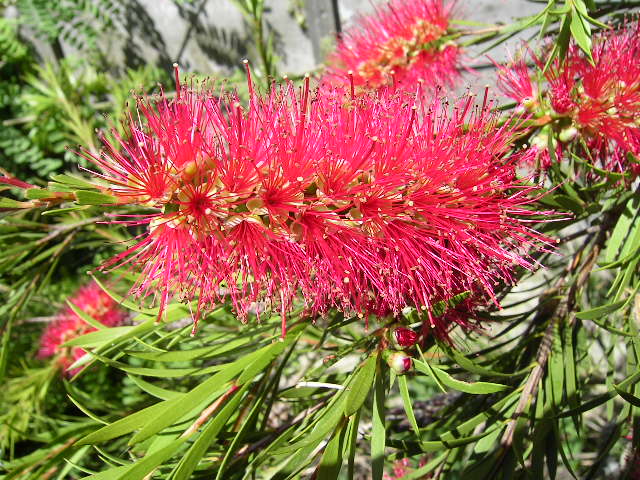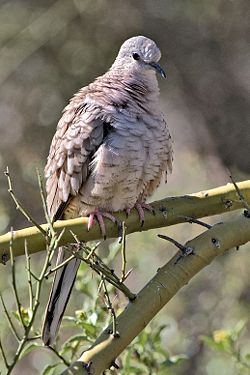
Hi Everybody!!
On Earth Day, I planted trees as planned. Your photostudy is of the new Bottlebrush Tree. These very unusual flowers do look like bottle brushes! This tree lost most of his blooms on the ride to my house. He will recover quickly. I am naming this new tree the "Wilson Tree" in honor of my G+ friends: David Wilson and his wife, Jane Wilson. They live in Scotland and take adventure walks around different beautiful places. Be sure to check out their G+ Photo Albums to see the Nature they share with the world. Hi David and Jane: this is your tree in Texas (I planted it on Tuesday). My assistant tree planter is shown below as is info from Wikipedia on this lovely tree. Enjoy!




https://plus.google.com/u/0/photos/117645114459863049265/albums/6006412776793363761



https://en.wikipedia.org/wiki/Callistemon
Callistemon
From Wikipedia, the free encyclopedia
Callistemon /ˌkælɨˈstiːmən/[2] is a genus of 34 species of shrubs in the familyMyrtaceae, all of which are endemic to Australia. It is sometimes considered a synonym of Melaleuca,[1] and four Callistemon species from New Caledonia were moved to that genus by Lyndley Craven and John Dawson in 1998. Callistemonspecies are commonly referred to as bottlebrushes because of their cylindrical, brush like flowers resembling a traditional bottle brush. They are found in the moretemperate regions of Australia, mostly along the east coast and south-west, and typically favour moist conditions so when planted in gardens thrive on regular watering. However, at least some of the species are drought-resistant. Several species are used in ornamental landscaping elsewhere in the world.
Callistemons can be propagated either bycuttings (some species more easily than others), or from the seeds. Flowering is normally in spring and early summer(October–December), but conditions may cause flowering at other times of the year. The obvious parts of the flower masses arestamens, with the pollen at the tip of the filament; the petals are inconspicuous (see picture). Flower heads vary in colour with species; most are red, but some are yellow, green, orange or white. Each flower head produces a profusion of triple-celled seed capsules around a stem (see picture) which remain on the plant with the seeds enclosed until stimulated to open when the plant dies or fire causes the release of the seeds. A few species release the seeds annually.
They are relatively slow growing though in time the larger species can grow up to 15 m (49 ft). Some are ground-hugging, and grow to only 0.5 m (1.6 ft). The leaves are linear to lanceolate and they are not deciduous.
They have been grown in Europe since a specimen of C. citrinus was introduced toKew Gardens in London by Joseph Banks in 1789.
In Australia, Callistemon species are sometimes used as food plants by the larvae ofhepialid moths of the genus Aenetus including A. ligniveren. These burrow horizontally into the trunk then vertically down.
In India, bottlebrush plants/trees are grown in gardens. Their leaves have a lovely fragrance which gets released on crushing the leaves with hands.
| Callistemon | |
|---|---|
 | |
| Red bottlebrush flower | |
| Scientific classification | |
| Kingdom: | Plantae |
| (unranked): | Angiosperms |
| (unranked): | Eudicots |
| (unranked): | Rosids |
| Order: | Myrtales |
| Family: | Myrtaceae |
| Subfamily: | Myrtoideae |
| Tribe: | Melaleuceae |
| Genus: | Callistemon |

Callistemon pallidus

Callistemon citrinus

Here is a link to interesting info:
http://www.foragingtexas.com/2006/12/bottlebrush-tree.html

My Earth Day Assistant Planter: Fat Sissy!


https://en.wikipedia.org/wiki/Inca_Dove
Inca Dove
From Wikipedia, the free encyclopedia
The Inca Dove (Columbina inca) is a small New World dove; it might belong to the genus. It ranges from the southwestern United States and Mexico throughCentral America to Costa Rica; the Inca Dove only lives on the Pacific side of Central America. Despite being named after the Inca Empire, this species does not occur in any of the lands that constituted that region. Inca Doves are common to abundant within their range and they are expanding their range north and south.
Inca Doves reach a length of 16.5–23 cm (6.5–9.1 in) and weigh 30–58 g (1.1–2.0 oz).[2] They are slender, with a gray-brown body covered in feathers that resemble a scaled pattern. The tail is long and square, edged with white feathers that may flare out in flight. In flight, the underwing is reddish, like other ground doves, and on takeoff, the wings produce a distinctive, quiet rattling noise.
This is a terrestrial species which occurs in flocks in open areas including scruband cultivation. It will feed in urban areas, eating grass seeds and taking advantage of the ready availability of water from agricultural and suburbanirrigation. The song, a forceful cooing rendered variously as "cowl-coo" or "POO-pup", may be given from a tree, wire, or other open, high perch such as a television aerial.
During winter, they roost in communal huddles in a pyramid formation that helps them conserve heat. These pyramids can contain up to 12 birds.[3]
Inca Doves live near areas of human habitation and feed in opens areas such as lawns and barnyards. They build their nests primarily in trees and shrubs. The male gathers the nesting material and presents it to the female, who also gathers some nesting material. The nest is composed of twigs, grass, and leaves and becomes reinforced with the brood's excrement.[4]
| Inca Dove | |
|---|---|
 | |
| Conservation status | |
| Scientific classification | |
| Kingdom: | Animalia |
| Phylum: | Chordata |
| Class: | Aves |
| Order: | Columbiformes |
| Family: | Columbidae |
| Genus: | Columbina |
| Species: | C. inca |







...this is brendasue signing off from Rainbow Creek. See You next time! Celebrate Earth Day Everyday

O+O



No comments:
Post a Comment
Hi Everybody! Please say hello and follow so I know you are here! Due to the inconsideration of people trying to put commercials on my blog comment area, I have restricted use of anonymous posts. Sorry that some hurt all.
My public email is katescabin@gmail.com No spammers or trolls